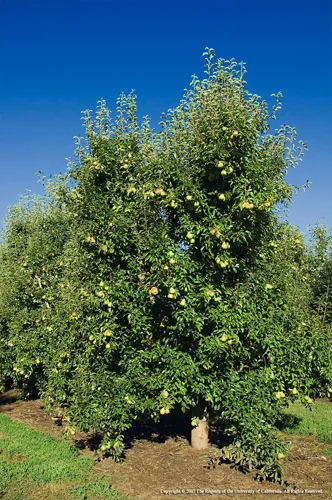| Propagation | Scion & Rootstock Selection | Orchard Establishment | Flower, Fruit & Cultivar Photo Galleries | Deficiencies & Pests | Harvest & Postharvest | Reviewers & Credits | References & Links |

Common Types
The two most common types of commercial pears are European pears (Pyrus communis) and Asian pears (Pyrus pyrifolia), named according to their area of origin. Both species of pear are closely related to apple, and classified as “pome fruits”, within the Rosaceae family. European pears lead the California market, total acreage and tons of fruit produced (Hancock and Lobos 2008; USDA 2012). In California, Bartlett is the most commonly cultivated cultivar because it is better suited to hot climates (Elkins et al. 2007) and it is appropriate for all types of consumption, including fresh, dried, canned and processed (including baby food and juice concentrate). Bosc and Anjou cultivars dominate Oregon and Washington production, as they are better suited to grow in cooler climates. In California 88,000 acres of Bartlett represent about 75% of pear acreage in the state. (USDA 2014)
Fruit Set
Bartlett pears can set fruit with pollination or via vegetative parthenocarpy, without differences in fruit yield. Bartletts commonly set fruit parthenocarpically in California (Reil 2007). To ensure some fruit set via outcrossing, and enhance fruit set in a parthenocarpic orchard, bees can be used to optimize fruit yield. Some California pear growers plant pollinizer trees to maximize outcrossing, with bee hives placed nearby prior to bloom and extending throughout the bloom period (Reil 2007). Outcrossed trees have a tendency to alternate bear, while parthenocarpic tree yields are relatively consistent across years (Elkins, Van Den Ende and Beutel 2007).
Growing Conditions
Pears grow best in well-drained clay loam soils that retain moisture. Slightly acidic to neutral pH is preferred for pear growth, while alkaline soils can result in tree yellowing and iron chlorosis (Reil 2007). For optimum yield, pear trees need 10 to 20% more water than the reference evapotranspiration (ET) from late spring to late summer (Reil 2007). Irrigation is especially important in June when the fruit are increasing in size. The amount of irrigation water applied can be decreased in the fall in drought years (Elkins et al. 2007).
European pear cultivars commonly grown in California are better suited to the warm climate in California, warm summer temperatures are necessary for proper fruit maturation. Without warm temperatures during the six to eight weeks prior to harvest, pears will not attain optimum shipping quality (Elkins et al. 2007). Additionally, pear trees in Sacramento, Lake and Mendocino counties (primary growing regions) have a greater survival rate if located near cool water because it decreases the incidence of fire blight, frost, freeze and drought (Elkins et al. 2007).
All commercial orchards harvest pear fruit prior to ripening. Fruit mature on the tree until they reach a minimum firmness and sugar content required for harvest. Pears are harvested early because they are climacteric fruit (temperature and both external and internal ethylene concentrations affect ripening) and ripen rapidly after reaching their climacteric peak. Additionally, pears do not achieve optimal flavor when ripened on the tree (Mitcham and Mitchell 2002).

